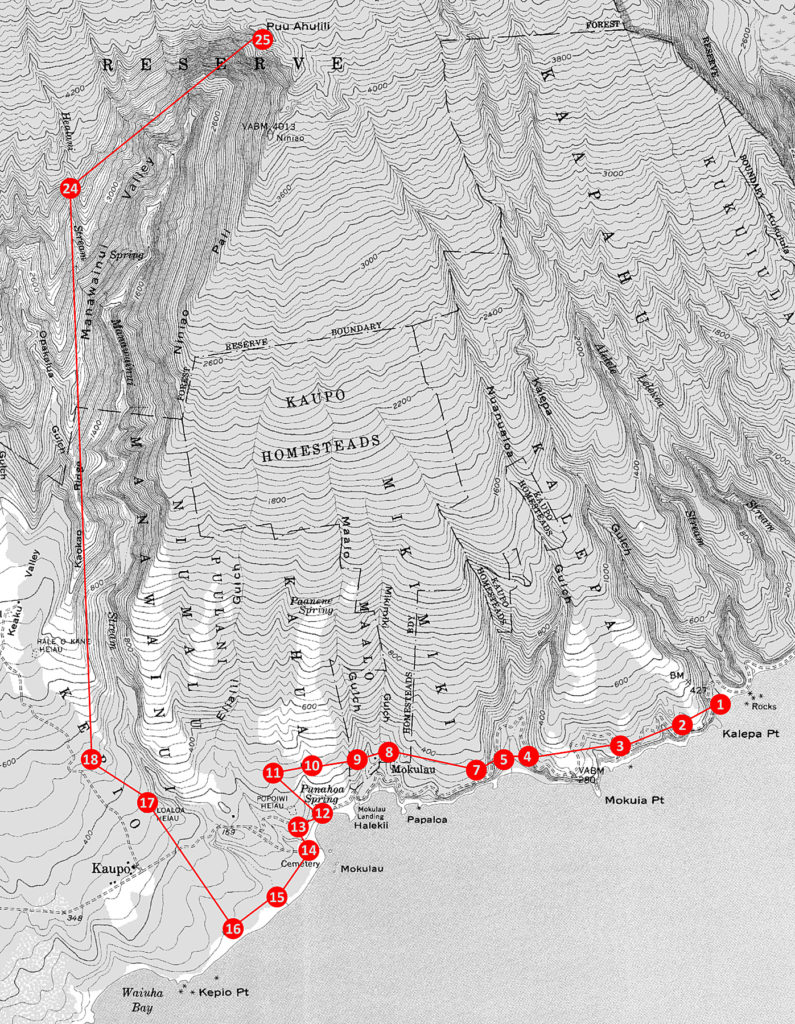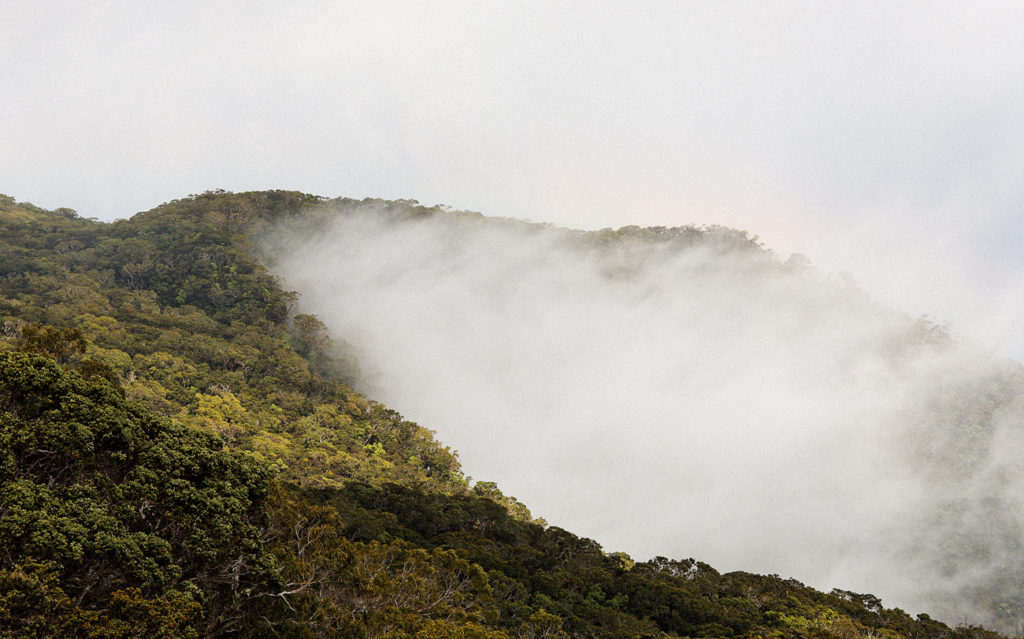Kaupo is full of stories of chiefs during the period just before and after Western contact. In the early 1700s, Maui chief Kekaulike made Kaupo his royal seat. Soon after, Kaupo was a battleground between the chiefs of Maui and Hawaii Island. Kamehameha I, the first ruler of all the Hawaiian islands, first rose to prominence in a battle at Kalaeokailio Point in Kaupo.
But long before these chiefs made their mark in Kaupo, there was Heleipawa, a chief from the legendary period centuries before Western contact. However, Heleipawa’s connection to Kaupo is not based on what he did while he lived, but what happened to him after he died.
Hawaiian historian Davida Malo, who wrote a history of the islands in the 1840s-1850s, described Heleipawa this way:
“Hele-i-pawa was a chief who was born at Lelekea, Ka'apahu, in Kipahulu on the island of Maui. He died at Poukela, and his bones were deposited at Ahulili.”
Here, Poukela is a shoreline area with a heiau (temple) west of Mokulau. Ahulili is a remote hill at the top of Manawainui Valley, 4,600 feet above sea level.
While this excerpt provides a tantalizing glimpse of the early chief, in 1869, Samuel Kamakau, another native historian, provides a longer chant about Heleipawa. Kamakau gives a detailed itinerary of Heleipawa's funeral procession, and this chant is a valuable source of Kaupo place names.
Kamakau’s chant, published in the newspaper Ke Au Okoa on Oct. 21, 1869, is presented below at left, along with an English translation at right from the book Tales and Traditions of the People of Old.
O Heleipawa o ke alii o Kipahulu,
I hanau i Lelekea,
O Pieleku ke ewe,
O Paokahi ka piko,
I Hekeu i Kuai ka aa,
I ka Kahaleikalale kahua.
I ka piina i Keahuala i Makaaoa
I Kaapahu mauna i ka lani,
I Kaloiki la i Kalonui,
I ke alahaka i Manokiai,
I ke ala hoolewa i Nahunonapuunalu,
I ke alahauiki a Kana,
I ke Anawao i Kalepa,
I Waiahole la i Hualele,
I Puualaea i Nuanualoa,
I Puolokalina i Kalaeoaihe,
I Mikimiki la i Maalo,
I Kahuwai i Popoiwi,
I Punahoa i Kanemalohemo
Mokulau la i Muliwai,
I Poukela i Loaloa i Puumakaa,
I Kaakaukawa i Kawahaohinau,
I Nakukuioolu i Paliakoae;
I Kaheka ilalo,
I uliuli mauna iluna;
I Helaniku i ke poo o Kauhau
I Ahulili, waiho no o Heleipawa.
Heleipawa, the chief of Kī-pahulu,
Was born at Lelekea;
At Pielekū the placenta,
At Paokahi [heiau] the navel cord,
At Hekeu, by Kuaʻi, the caul,
Ka-hale-i-kalalea the [house] site.
Along the ascending path to Keahualā on Makaʻaoa
In Kaʻapahu, the mountain in the sky,
To Kaloiki, to Kalonui,
Along the rough road to Manokiaʻi,
Along the funereal path to Nāhunonapuʻunalu,
Along the trail of Hauiki-a-Kana,
By the inland cave in Kālepa,
Through Waiāhole, through Huʻalele,
Through Puʻualaea, to Nuʻanuʻaloa;
To Puʻolokālina in Kalae-o-ʻaihē;
Through Mikimiki, through Maʻalo;
Through Kahuwai to Popoiwi,
To Punahoa, to Kānemalohemo
At Mokulau; to Muliwai,
To Poukela, to Loʻaloʻa, to Puʻumakaʻā,
To Kaʻakaukawa, to Kawahaohinau,
To Nākukuiʻoʻolu, to Pali-a-koaʻe;
To Kāheka below,
To the dark-hued mountain above;
At Helanikū, on the top of Kauhau
On ʻAhulili, Heleipawa was laid away.
In total, 26 places in Kaupo are mentioned, starting with Kalepa at the boundary of Kaupo and Kipahulu. However, one of these places, Kauhau (a ridge west of Manawainui Valley), is only mentioned to provide context for the location of Helaniku. According to the chant, Heleipawaʻs body was taken through 24 places in Kaupo before being placed at the 25th, Ahulili. These 25 locations are listed below at left and identified on the map at right.
- Kalepa
- Waiahole
- Hualele
- Puualaea
- Nuanualoa
- Puolokalina
- Kalaeoaihe
- Mikimiki
- Maalo
- Kahuwai (Kahuai)
- Popoiwi
- Punahoa
- Kanemalohemo
- Mokulau
- Muliwai
- Poukela (Paukela)
- Loaloa
- Puumakaa
- Kaakaukawa
- Kawahaohinau
- Nakukuioolu
- Paliakoae
- Kaheka
- Helaniku
- Ahulili

Plotting the locations on the map above shows how Heleipawa's body was taken along the coast, followed by a sharp turn inland and up the Haleakala mountainside to Ahulili. The spot where they turned inland was Paukela.
A number of places that Kamakau mentions are found in no other map or other document. While their specific locations are unknown, because of the roughly linear path of Heleipawa, their approximate areas can be determined.
Puolokalina (#6 in the list above) is one of those places. It must lie somewhere between Nuanualoa (#5) and Kalaeoaihe (#7). Because Nuanualoa and Kalaeoaihe are relatively close, the approximate location of Puolokalina can be determined with a fair degree of certainty.
More difficult are the 5 unknown places between Puumakaa (#18) and Helaniku (#24). These are Kaakaukawa, Kawahaohinau, Nakukuioolu, Paliakoae and Kaheka. At best, we can assume that they lie on or close to the straight line between Puumakaa and Helaniku. Additionally, some name translations offer clues, such as "tropicbird cliff" for Paliakoae.
An obvious question is, when did Heleipawa live? 19th-century historians Davida Malo and Abraham Fornander placed Heleipawa around the time that the legendary priest Paao arrived in Hawaii from a foreign land. Fornander judged that Paao lived in the 11th century, but recent research suggests AD 1400 as a more likely time.
Circa AD 1400 also corresponds with age estimates for Loaloa Heiau. Archaeologist Michael Kolb has performed radiocarbon dating at Loaloa, and the earliest possible dates from that testing were in the 1400s. For Puumakaa and Paukela heiau, no scientific dating (radiocarbon, coral, etc.) has been conducted, but if Heleipawa's chant is taken as truth, then those temples may date to the 1400s as well. (Kolb's radiocarbon dates from Popoiwi indicate it may have been built as early as the 1300s).
Of course, all of this rests on tenuous assumptions: that Heleipawa was a real person, that the legends placing him in the time of Paao are factual, that that Kamakau’s funeral procession is accurate. However, there is often a grain of truth at the heart of legends.
